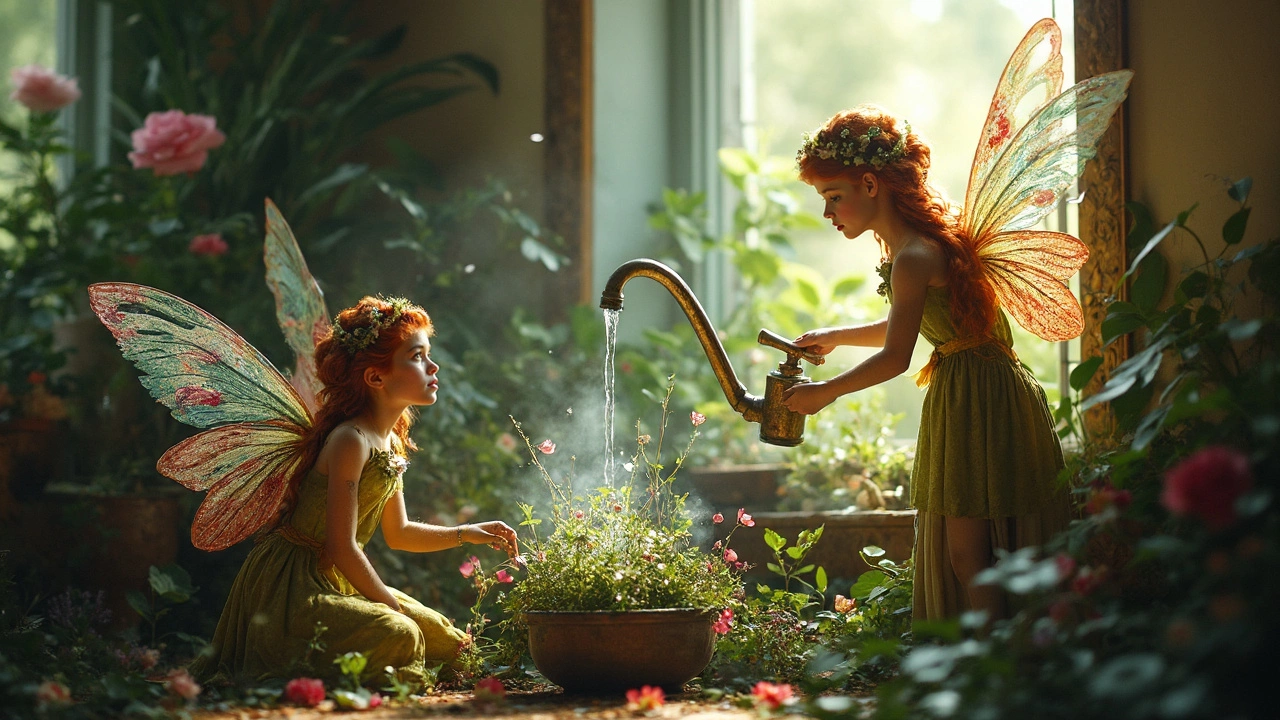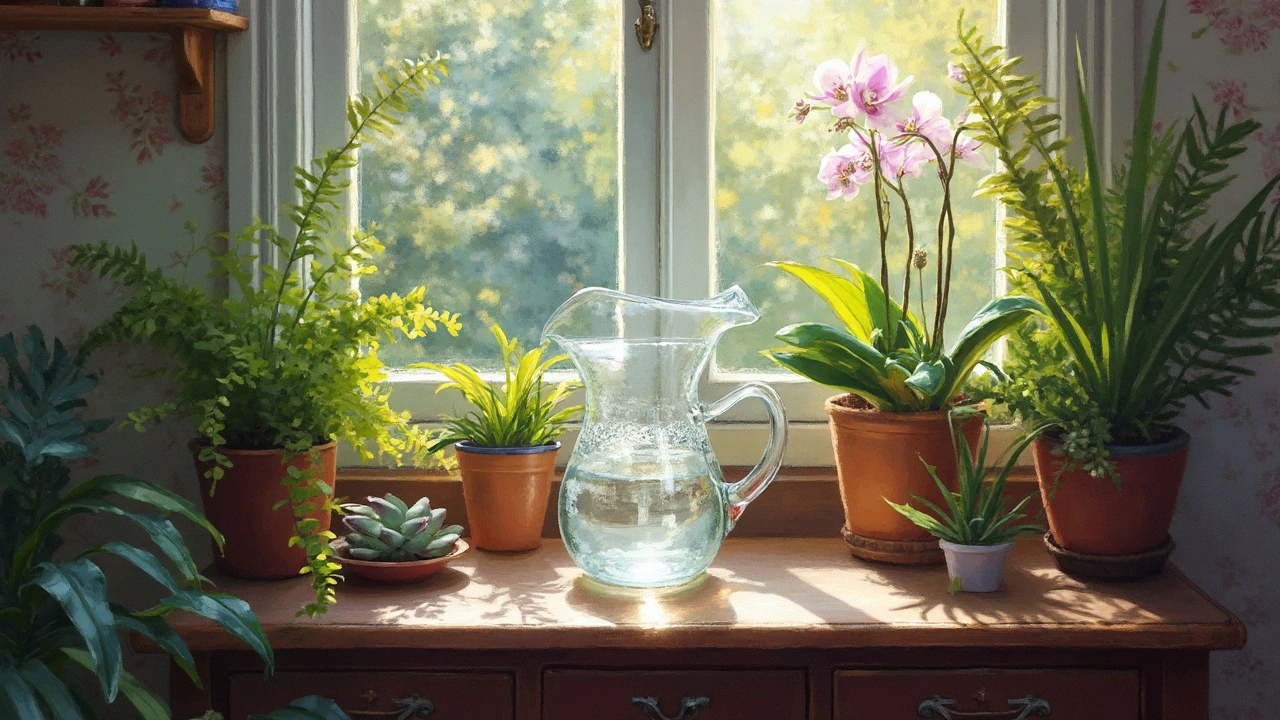Watering your plants might seem straightforward, right? But wait—there's a bit more to it when it comes to using tap water. Most of us just fill up a watering can and go to town, but here's an insider tip: letting your tap water sit for a bit before you use it can be a game-changer for your indoor jungle.
Why, you ask? Well, tap water often contains chlorine and other chemicals that help make it safe to drink. However, these chemicals aren't always plant-friendly, especially for sensitive indoor plants. By letting tap water sit for about 24 hours, these chemicals can evaporate, making it much safer for your leafy friends.
Not all plants are equally picky, though. Some robust species might not mind a bit of chlorine, but if you're caring for ferns or tropical plants, they might thank you for your patience.
- The Role of Tap Water in Plant Care
- Why Let Tap Water Sit?
- Timing for Optimum Plant Health
- Recognizing Sensitive Plants
- Alternatives to Tap Water
- Practical Tips for Watering
The Role of Tap Water in Plant Care
At first glance, tap water seems like the easiest option for keeping indoor plants hydrated. After all, it's readily available and doesn't cost extra. However, there's more to tap water when you consider the health of your plants.
Chemicals Present in Tap Water
Your local water treatment plant does an excellent job at keeping water safe for us humans by adding chlorine and, sometimes, chloramine. But, for certain plants, these chemicals act like unwelcome guests at a party. Chlorine, in particular, can hinder plant growth by interfering with their ability to carry out photosynthesis.
Minerals and pH Levels
Tap water also comes with dissolved minerals like calcium and magnesium. Over time, these minerals can build up in the soil, creating a crusty film which messes with soil health. Plus, tap water's pH level might not always be ideal, especially for picky plants that thrive in slightly acidic or alkaline soils.
Water Hardness Matters
The hardness of your tap water reflects the mineral content, which varies based on location. Hard water means more minerals, and while these don't harm most humans, plants can suffer from excess build-up, leading to soil issues and root problems.
| Type of Water | Chlorine Content | pH Level |
|---|---|---|
| Soft Tap Water | Medium | 6.5 - 7.5 |
| Hard Tap Water | High | 7.5 - 8.5 |
Understanding what's in your tap water can help tailor approaches best suited for your plant's specific needs.
Why Let Tap Water Sit?
Ever wondered why you should let your tap water sit before it meets your plants? It might sound unnecessary, but it’s all about creating a healthier environment for your plants. Tap water often contains chemicals like chlorine and, in some areas, chloramine, used to keep our drinking water clean. However, such additives don't add much benefit to plants and could cause harm over time.
Chlorine's Disappearing Act
When tap water is left out, chlorine and other volatile compounds begin to evaporate. Typically, giving the water about 24 hours lets these chemicals dissipate enough to become less threatening for your plants. This is especially crucial for sensitive plant varieties like ferns and certain tropical beauties.Impact of Hard Water
If you're dealing with hard water, your plants might be getting a dose of minerals such as calcium and magnesium. While small amounts can be fine, an overload can interfere with nutrient absorption in plants. By allowing water to sit, you might also have time to detect any mineral sediment building up at the bottom, though filtering is another great option here.The Science of Settle Time
Some experts suggest a minimum of 24 hours, but if you have the patience, a little longer won’t hurt. This waiting period helps make the water more plant-friendly and is an easy way to support healthier growth.The bottom line is, even small actions like letting tap water sit can make a big difference. It's a simple way to remove unwanted chemicals and promote a healthier watering routine. So next time you're watering, give your tap water a bit of a breather first!
Timing for Optimum Plant Health
If you're serious about your indoor plants thriving, timing is everything. Letting your tap water sit isn't just a suggestion; it can actually change the game for your green buddies.
Most experts agree that the magic number is around 24 hours. Why 24 hours? This window gives enough time for chlorine and any other volatile chemicals to evaporate. Nobody's got time to micromanage the nitrogen cycle in their living room, but these few hours can make a noticeable difference in plant health.
Why Not Longer?
You might wonder why not let it sit longer, maybe two or three days? Well, there are downsides to extreme caution too. Letting water sit too long risks bacterial growth, which isn’t ideal for either your plants or your nose. It's all about finding that sweet spot.
How to Maximize This Waiting Time
- Fill whatever container you're using, a jug or a watering can, with tap water.
- Leave it uncovered in a well-ventilated room to speed up evaporation of unwanted chemicals.
- After 24 hours, your water is ready to give those plants a good, chemical-free soak.
Many plant lovers use this trick and see a notable improvement, especially with their more sensitive species like ferns or palms. Simple tricks like these can make your plant game go from zero to hero in no time. So, next time you're prepping to water, just remember: patience pays off, even in the plant kingdom!

Recognizing Sensitive Plants
Alright, so not every plant in your home will throw a hissy fit if you use tap water. But there are some that definitely will. These fall under the category of sensitive plants, and knowing which of your green companions needs extra care can save you a lot of heartache.
Telltale Signs of Sensitivity
How do you know your plant is sensitive to the chemicals in tap water? Watch for curling leaves or brown leaf tips. These are often signs that your plant isn’t loving what you’re giving it.
Known Sensitive Species
Some plants are notorious for being divas when it comes to watering. Ferns are a classic example—they love humidity but hate chlorine. Spider Plants are another sensitive species; they might develop scorched leaf tips if exposed to harsh chemicals. Orchids, known for their exotic beauty, also prefer their water to be as chemical-free as possible.
Why They’re Sensitive
The reason certain plants are more sensitive comes down to their natural habitats. Many tropical plants are used to rainwater, which is free from chlorine and other additives found in tap water. Indoor plants like these thrive under similar conditions when you replicate those environmental factors as closely as possible.
Taking Extra Steps
If you identify your plant as sensitive, consider exploring alternatives like rainwater or distilled water. Alternatively, let your tap water rest for at least 24 hours. This simple step can improve the quality of the water and make your sensitive plants happier.
Alternatives to Tap Water
If you're not totally sold on using tap water even after it's been sitting, no worries—there are a couple of awesome alternatives you can try for your indoor plants. Each has its own perks, so it's worth considering based on the needs of your plant babies.
Distilled Water
Distilled water is basically purified through boiling and condensation, removing all minerals and chemicals. This makes it super gentle and safe for the most sensitive plants. The downside? It can be a bit pricey if you're buying it regularly, but it's perfect for fussy plants that react to chlorine or fluoride in tap water.
Rainwater
Rainwater is like liquid gold for plants—it’s naturally soft and free from chemicals found in tap water. If you can collect and store it safely, it's an awesome, eco-friendly choice. Keep a barrel outside to catch the rain, and just make sure it's covered to prevent debris and pests.
Brita Filtered Water
If you already have a water filter for drinking water, use it for your plants too! Filtering through something like a Brita can reduce chlorine and heavy metals.
Boiled Tap Water
Boiling your tap water and then letting it cool is a simple trick to reduce chlorine levels. It's a bit more of an effort than other methods, but it works if you're in a pinch and want to avoid spending extra on distilled water.
| Water Type | Pros | Cons |
|---|---|---|
| Distilled Water | Free from chemicals, good for sensitive plants | Costly long-term |
| Rainwater | Chemical-free, eco-friendly | Dependent on weather |
| Brita Filtered Water | Reduces chlorine and metals | Requires a filter |
| Boiled Tap Water | Reduces chemicals | Time-consuming |
Overall, experimenting with different types of water can help you figure out what keeps your green friends happy and lush, especially if they've been looking a bit under the weather. These alternatives can make all the difference in the world for plant health, especially if watering them straight from the tap hasn't been working out.
Practical Tips for Watering
When it comes to watering indoor plants, a few practical tweaks can make all the difference. Here's how to level up your tap water game to ensure your green companions thrive.
Check the Temperature
Always make sure the water temperature is right. Plants don't like cold shocks any more than we do. Room temperature water is your best bet. Simply fill your watering can and let it sit in the room for a while before watering.
Use the Right Tools
A watering can with a long spout gives you better control and prevents water from overflowing onto leaves. Too much water on the foliage can lead to mold or mildew issues.
Observe and Adjust
Pay attention to how much your plants drink. Most plants appreciate thorough watering, meaning you should water until it flows out of the pot's drainage holes. However, there are some options:
- For succulents and cacti, give them a good soak and then let them dry completely between waterings.
- If you're dealing with tropical plants, they usually like consistently moist soil.
Alternatives to Tap Water
Can't wait for tap water to settle? Consider using distilled water or rainwater, which are free from chemicals. A small investment in a rain barrel can provide you with a natural water source that your plants will love.
| Type of Water | Good For |
|---|---|
| Tap Water (sat for 24h) | All general houseplants |
| Distilled Water | Sensitive plants |
| Rainwater | All-purpose, especially tropical plants |
Consistency is Key
Create a watering schedule. Saturdays are a safe bet for a weekly routine, but always check your plants’ soil. Stick your finger into the soil up to the second knuckle, if it's dry, it's probably time for a drink.
